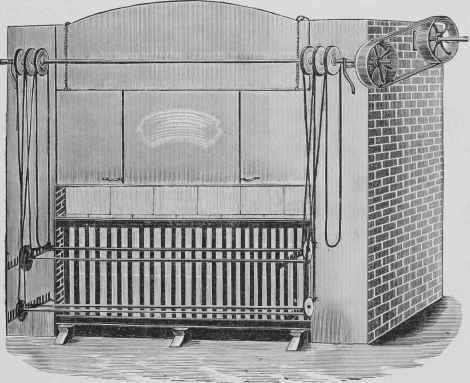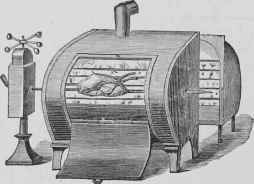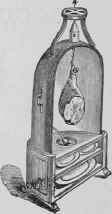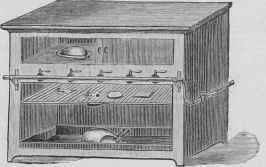Roaster And Spits (Rotissoire Et Broches)
Description
This section is from the book "The Epicurean", by Charles Ranhofer. Also available from Amazon: The Epicurean, a Complete Treatise of Analytical and Practical Studies on the Culinary Art.
Roaster And Spits (Rotissoire Et Broches)
In large kitchens the only roaster possible is the one shown in Fig. 115 with its broad hearth, long .spits, long hanging chains and wheels; an endless chain with a weight sufficiently heavy to rotate it, steam, electricity or hydraulic pressure can to be used advantageously to attain the same end. Fig. 117, represents a roasting spit for small game, quails, woodcocks, thrush, etc. It is provided with six skewers; run the game on to one of these through the two leg bones; use as much as possible the different sides for different games, for instance one side for quails, partridges or thrush and the other three skewers for snipe, woodcock, plovers, bustards, etc. These spits are very useful for large dinners, for eight quails can be put on each skewer or forty-eight quails can be roasted at once without having them too crowded. The length of the spit is sixty-eight inches and the length of each one of the six skewers is twenty inches. For cradle spit No. 116, the cut of meat to be roasted such as loin, the saddle is placed exactly in the center to regulate the weight evenly. The simple spit for poultry, game, turkey, etc. is shown in Fig. 118. A spit being at times an impossibility, one is frequently obliged to have resource to the more simple roasters.
The greatest objection to the old fashioned shell roaster is that the spit did not turn alone, it had to be everlastingly turned for if left the meat would certainly spoil; a great improvement on this is the turning spring spit to be wound up like a clock and strikes an alarm when slackening by the movable balls of the fan striking on a gong (Fig. 119). There are other roasters having two spoons turning at the same time as the spit feeding a small reservoir found on the top of the spit and through a shallow furrow perforated by small holes, the meat is continuously basted. The three pieces composing this oven are movable and can therefore be transported to any desirable place; the shell can easily be fastened on to the wall. There are also English spits adapted for all hearths (Fig. 120); it is easy to fasten it to a movable hearth fitting with the spit. These are run by clock work placed on top; the roasts are suspended perpendicularly and always turn in the same direction.

Fig. 115.
Fig. 116.
Fig. 117.
Fig. 118.

Fig. 119.

Fig. 130.
Fig. 121 represents a wrought or sheet iron pan; the interior has a basket which is used for frying small fish, potatoes, croquettes, etc. Place inside the objects intended for frying and plunge the basket into the frying fat after it has attained the required heat; the articles being cooked and of a fine color, withdraw the basket to drain them properly.
Fig. 122 represents a copper case containing four high saucepans called bain-maries. A bain-marie consists of a vessel filled with boiling water into which is placed another vessel containing the substances that are required to be heated. The materials placed in the second vessel can only acquire the temperature of the boiling water and heat gradually and progressively and therefore can be stopped at any time. Each saucepan should be ticketed with the name of the sauce it contains so that any sauce or soup can be selected without wasting time in searching for it.

Fig. 131.

Fig. 133.

Fig. 123.
Fig. 123. The salamander and oven hithertofore used in kitchens to glaze or brown dishes presented difficulties on account of the attention and watchful care it necessarily-required. By means of the new gas salamander, fish can be almost instantaneously glazed when covered with a well thickened or buttered sauce without any danger whatever of having the sauce curdle. This salamander is lighted by gas and can be fastened to the wall at the back of the range. It consists of two platforms, the upper one fixed and the lower one movable and sufficiently big to place the largest dishes on it. Naturally the gas comes from the top and it is easy to regulate its intensity by a stop cock. Two minutes suffice to obtain a perfect glazing without having the bottom of the dish attain the slightest heat, thus the sauce cannot deteriorate whatever. It is an indispensable utensil and assists the cook greatly both as regards its usefulness and speed.

Fig. 124.
Fig. 124 is the reproduction of a very useful broiler, offering numerous facilities for various purposes. The broiling takes place in a metal case, it being provided with five gas tubes, having the sides bored with small holes, the gas projects into small bells to have it purified and then can be used for broiling without the annoyance of smell nor smoke. It is principally used for broiling toasts, canapes, or toasts for sandwiches"; meats can also be broiled thereon such as cutlets, chops and beefsteaks. When the bottom is closed with a movable door, it can be used for roasting chickens, legs of mutton, beef, etc. The top part is useful for keeping things hot. All gas stoves can be regulated and moderated, according to the work, by modifying or increasing the volume of gas.
Fig. 125 shows a singeing apparatus shaped like a horn; the largest part, from whence issues the flame is covered with a very tine metallic cloth which causes the flame to become enlarged. There is an opening on the other or thin-end about an inch in diameter for the purpose of combining the air with the gas, forming a Bunsen burner. Poultry and game can be singed without blackening the skin whatever.

Fig. 135.

Fig 126.
Fig. 126 is a steam table with covered dishes, cases and bain-maries. The square boxes are used for soups, stews, etc.; the covered dishes for large pieces of meat to be carved and for entrees; the small steamers are for keeping the sauces and gravies. Instead of a dish on the right, place a carving-board with a knife and fork. The inside is used for keeping the dishes hot before and after they are dressed. These steam tables are heated by steam or gas, and are advantageously used either as a hot closet or as a substitute for a chafing dish.
Continue to:


